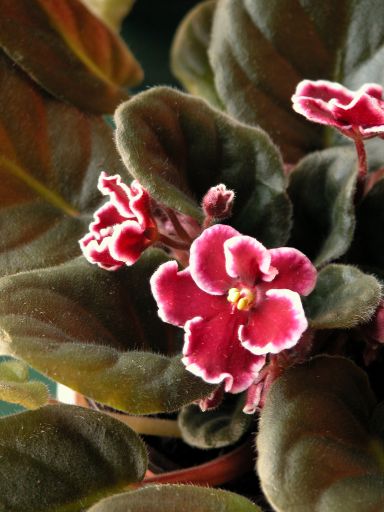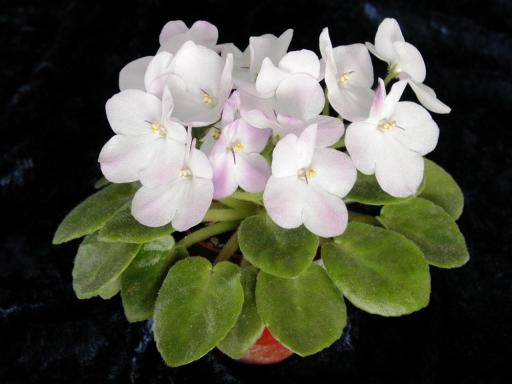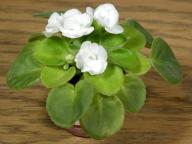African Violets (Saintpaulia hybrids)
African violets are among the most common, and presumably most popular, of flowering houseplants. Hardly a place that sells plants will not have at least a few of these Saintpaulia ionatha hybrids in stock. These mastheads of the gesneriad family are so popular because they're hard to kill and fairly easy to flower. I've almost always had a few pots growing in northern windows, since they're one of the few plants that will actually flower in low light.
The foliage will develop light spots if touched by cold water. Because of this, most people water African violets by pouring water into the saucer and letting capillary action moisten the soil. It's actually the cold bit, rather than the wet bit, that they don't like; warm water doesn't spot the foliage. They're fairly succulent plants, so they don't need to be watered all the time, and their roots appreciate being able to dry out between waterings. A light, peaty soil gives good drainage and aeration, and many standard commercial potting mixes work well for growing violets. Of course, there are also specialty African violet potting mixes out there too, if you want to spend the money.
Honestly, I've lost interest in growing violets. They were among the first plants I started growing, and after years of average-looking plants, I'm more interested in growing plants that are a little less ubiquitous. While African violets endure quite a bit of neglect, they don't do it in silence. Once a plant has wilted a couple times, it will never quite recover its initial good looks. The fuzzy leaves collect dust, too, and it doesn't take much of an accumulation of dust to make them look awful. Fortunately, it's easy enough to wash them off with a strong spray of warm water and let them dry in a warm place. Direct sunlight will bleach the leaves, and the foliage starts to look dull and discolored if they grow in the same old, tired soil too long.
I've given away or pitched all of my standard-sized violets in favor of miniatures. A well-grown standard violet can easily push foliage out over twelve inches across, and when the plants get that big it's all to easy to damage their leaves. It only takes one or two broken leaves to ruin the symmetry of the foliage, and that's especially easy to do while watering or trying to balance them on windowsills. On the other hand, a miniature African violet is content with a crown of foliage three to six inches across; it just seems easier to grow a miniature with a perfectly symmetrical round crown of foliage. The miniatures have flowers every bit as showy as the standard sized ones, and sometimes as large, too. Their tiny size makes them all the more impressive when in full bloom.
African violets grow well under artificial lights. They flower almost constantly when grown eight or ten inches below fluorescent tubes with 16 hours of light a day. With artificial light, it's easier to make sure they receive even lighting, which ensures a nice symmetric crown of foliage. It also gives them the space they need to spread out, which eliminates the need to balance big plants on skinny windowsills.
It's fairly easy to propagate African violets by taking leaf petiole cuttings. A healthy leaf and all of its stem (called the petiole) are removed from the plant and all but about an inch of the petiole is removed. The petiole is then dipped in rooting hormone, placed it in a sterile rooting medium like vermiculite or perlite, and kept constantly moist and warm. Over the course of a month or so, the leaf will root and send up a plantlet or two. Once they are large enough to be handled easily, they can be separated from the leaf and potted up in their own pots.
Click on the images to view larger versions.



